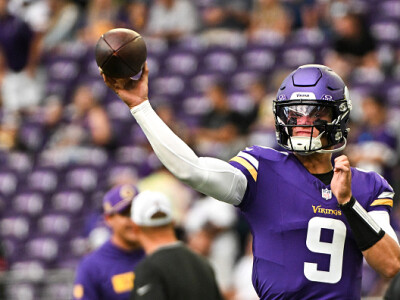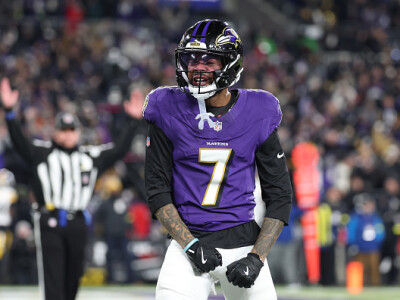2023 Fantasy Football Player Profile: Why You Should Be Fading Alexander Mattison at his ADP

We’re underway with preseason football as the Browns and Jets conclude their Hall of Fame Game in Canton, OH and the first NFL game of the season will be upon us in no time. Fantasy football ADP (average draft position) is shifting with each piece of news that comes out. Because of the reactionary nature of best ball and redraft ADP, no two drafts are the same despite the shifting landscape of fantasy and player evaluations.
One of the most polarizing running backs in fantasy this season is Alexander Mattison, who has been in a part-time role with the Minnesota Vikings since he was drafted in 2019, and now with Dalvin Cook being released earlier in the offseason, assumes a full-time role as the lead back. So it’s pretty clear we’re looking at a minimum 60-65% snap share and a ton of carries; what’s not to like? Mattison’s fantasy football rankings typically have him between RB18 to RB20 so far in early August. But is the juice worth the squeeze for 2023? Let’s dive in.
The Price
The price for Mattison currently sits at the end of the fifth round between a potentially falling Kenneth Walker because of his groin injury and holdout candidate J.K. Dobbins. That particular price is prohibitive and is the start of the dreaded “RB dead zone” which still does exist even though the “WR dead zone” has been a prevailing narrative this offseason.
Through the RB dead zone, the main sticking point about these running backs is one word: volume. Volume is king, of course, and especially true with running backs. Mattison is standing front and center right now for that volume and resides in a potentially explosive Vikings offense that could be doing very well in the scoring department in 2023.
One of the main arguments I have with Mattison is this: why draft him at the end of the fifth round when you can make the same exact bet with better running back profiles later?
Running backs like Miles Sanders, Cam Akers, D’Andre Swift, James Conner, and Rachaad White are backs that go later than Mattison with the same workload potential but go rounds later. If you’re looking to gather as many talented players as you can to stock up your roster and gun for a championship, you’ll need to be price sensitive and follow the ADP. Luckily, you’ll be able to do just that here with our ADP tool.
Is Mattison Even Good Enough to Hold the Job?
It’s kind of scary. And like many people chimed in within this thread and elsewhere, Mattison’s actual situation is a bit different than Davis’. Mattison has been on the Vikings for four seasons in a purely part-time role, while Davis bounced around the NFL, landed in Atlanta and had a starting job for Week 1. Until he didn’t. Mattison could meet that same fate in 2023.
The comparison with Davis is about early-season projectable volume, where Mattison’s huge downside is that he could lose carries (to somebody there or somebody being added to the backfield) and end up on the bad part of a running back committee; that's the same bet when people were drafting Davis in the fifth round a few years ago. Davis ended up losing rushing work to a 30-year-old former wide receiver and was rendered irrelevant by mid-season in 2021. This is the worst-case scenario for Mattison, but it’s plausible that he could lose work to the cohort of late-round picks and UDFAs behind him. His athletic profile leaves the door wide open for that.
Mattison was never that good of a prospect coming out of Boise St. and fell outside the top 100 picks in the 2019 NFL Draft. 4.6 speed and athletic profile comparisons to NFL busts La'Mical Perine, Shonn Greene, and Thomas Rawls don’t help matters either.
In three previous seasons in Minnesota, Mattison never could really wrestle away any sort of meaningful work and only started six games. Famously, Mattison is remembered for coming in to provide excellent games when he was the top back available, but looking closer into those games, three of those six games happened to be against a sad Detroit Lions defense. A player’s profile is not a three-game sample out of four seasons.
If Mattison was so good, why didn’t he force the issue just once in four seasons? Dalvin Cook had one of the worst seasons of his career in 2022, but Mattison could not force the issue and earn more playing time then. Cook’s ROE% (Rush percent over expected) — shortened to success rate by Pat Kerrane of Legendary Upside, who also compiled these stats — dropped from 45% in 2020 to 40% in 2021, to a bad 34% last season. This percentage measures consistency and how often a running back runs for more yards than expected. Cook was not good, and that’s in large part why he’s not signed by an NFL team as preseason begins.
Why couldn’t Mattison capitalize on a declining Cook season? Mattison was one of the worst pre-contact runners in the NFL, finishing 38th in the NFL among backs with 50+ carries with an average of 1.7 yards before contact. He was even worse in 2021, where he was 68th of 76 qualifying running backs with an average of just 1.2 yards before contact.
It’s possible the Vikings light the world on fire in the passing game and, in turn, it trickles down into the running game, where Mattison can pay off with touchdowns from a subpar rushing profile. That worked for a back like Jamaal Williams last season with 17 rushing touchdowns, but any kind of tangible improvement in Mattison’s problem areas would really help to shore up an upside profile that’s severely lacking.
The Next Men Up?
A big thesis for Mattison keeping and holding on to his volume is the perceived lack of talent behind him in the running backs room. Currently, the Vikings roster the following running backs:
Chandler is an interesting prospect who was a part-time player at Tennessee before he took over the North Carolina backfield after Javonte Williams and Michael Carter left for the NFL. He put up over 1,000 yards, 13 touchdowns on the ground, and 6.0 yards per carry. His 4.38 40 time at 204 pounds puts Chandler at a 93rd percentile Speed Score.
Nwangwu is an intriguing scatback who has more of a role on special teams as the primary punt returner. That said, he’ll be active on gamedays, as will the fullback Ham. McBride likely will be a healthy scratch unless somebody is hurt.
The Vikings could always bring in a free agent running back, and they’re absolutely live to do so. It’s increasingly likely that these free-agent running backs will remain unsigned into the regular season, so we’ll get to see if Mattison can shoulder the workload and boost his efficiency. If he doesn’t, and the Vikings are a live play to contend in the NFC or even the NFC North, they’re going to absolutely be in the market for a back if one of Chandler or McBride hasn’t earned more carries. That is the likely death blow to any meaningful fantasy role for Mattison.
The Verdict on Mattison
The running back bet in Rounds 5-8 with players like Cam Akers, James Conner, Miles Sanders, and JK Dobbins is about projectable volume
The problem with the bet on Mattison is that he has been legitimately bad on a per-carry basis over the last two seasons, so would I rather spend up on him in the fifth round or draft a Diontae Johnson-tier wide receiver, elite tight end, or elite quarterback?
Running backs have been pushed down in drafts, versus previous years, you couldn’t get anywhere close to the running back profiles you can get in the sixth or seventh this year.
If Mattison went in the seventh round this season, he’d probably be a solid pick when escaping out of the wide receiver dead zone, but he’s priced up way too high after the release of Dalvin Cook. There’s no reason for Mattison to be drafted in the fifth when a player can get every single great injury report a back can get (Javonte Williams) but barely budge when he doesn’t hit the PUP list. I’m fading Mattison at cost and only drafting him when he falls past the fifth round, and that doesn’t happen very often.



